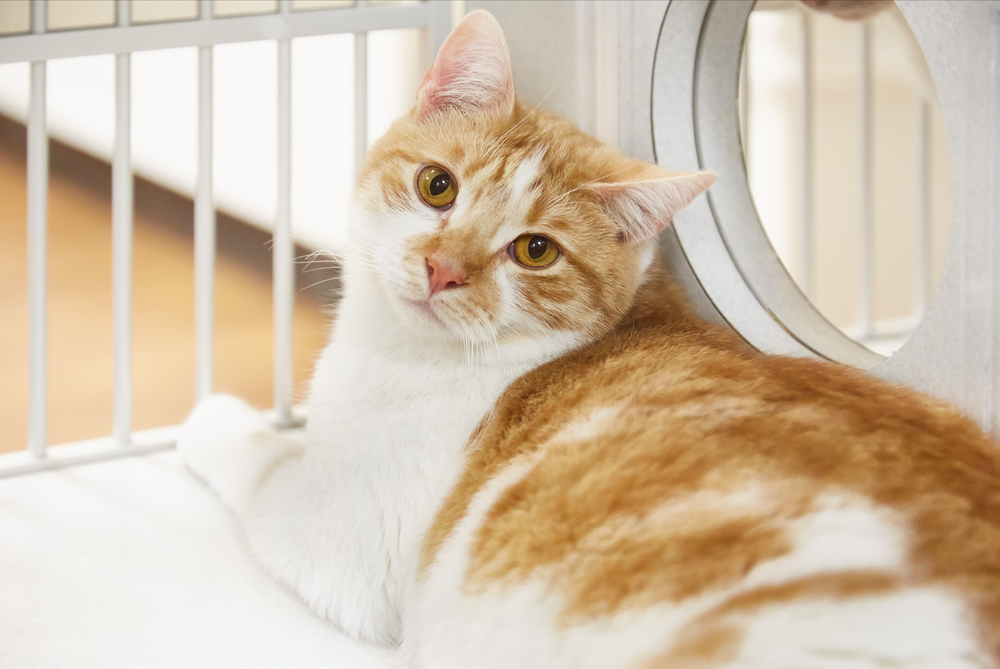
Katie Costello
Imagine that you are in a remote part of a foreign country and become so ill that you need to go to the hospital. People are coming at you and doing things you don’t understand. All of your senses are off: the way things smell, look, taste. Worse, you can’t understand anything said to you.
Yes, I am asking you to put yourself in the paw prints of shelter cats.
A Cat’s Senses
We all recognize that shelters are unnatural environments for animals, but understanding how cats perceive their environment can provide clues as to how to help them deal with their stress.
Kelly Bollen, MS, CABC, owner of Animal Alliances, LLC, describes in detail what cats perceive. For instance, think of how loud shelters are. Cats can hear up to 80 kilohertz; that is within ultrasonic range! By comparison, humans hear up to 20 kilohertz.
Cats have excellent vision and are sensitive to motion. They have 67 million scent receptors. Their vomeronasal organ pulls in pheromones signaling the emotions of cats around them. The pads of their feet are sensitive to touch and vibration. That means that in multiple ways cats are sensing all the other fearful and stressed cats in the shelter as well as other environmental stressors such as barking dogs, people walking up and down the halls, and radios blaring.
What Can We Do?
It should be our daily goal to decrease the fear that animals feel in our shelters. Drs. Kate Hurley and Julie Levy at the Million Cat Challenge, a joint project of the UC Davis and University of Florida shelter medicine programs, say that making sure each cat has the right amount of space is the most important thing a shelter can do to prevent stress and stress related diseases such as upper respiratory infections (URI): “Our research showed not meeting this space requirement was one of the biggest risk factors for respiratory disease in shelter cats.” That space requirement is:
- Individually-housed cats each require a minimum of at least 8.5 square feet of clear floor (not vertical) space.
- Cats in group housing need at least 18 square feet per cat, plus places to hide. And again: vertical space doesn’t count!
Laura K. Frazier, BA, RVT, and owner of www.advocatsconsulting.com as well as previous owner of Meow Town in Martinez, Georgia, shares some additional recommendations:
- Vertical space (even if cats are in their own space/kennel).
- Boxes for hiding, with the open part facing the rear of the cage.
- Moveable curtains or panels for privacy.
- Spray the space/kennel with Feliway before cats arrive or use a plug-in. If using spray, wait 15 to 20 minutes to allow the smell of alcohol to dissipate.
- Provide opportunities for scratching by attaching mats to walls or placing climbing posts in kennels.
- Offer social play with wand toys, especially if cats can’t be touched.
- Play yoga music or buy one of the CDs with music composed for cats such as “Through A Cat’s Ear.”
- Speak softly and move slowly. Try to eliminate noises such as banging doors, loud music, or radios on cages.
- Hide treats throughout cages so cats can hunt.
- Offer catnip.
- Allow cats opportunities to walk around and explore outside their cages.
- Allow cats to come out of carriers on their own instead of pulling them out. Place the open carrier in the cage so they can come out when they want.
From my own experience, I’ve found that hanging dried lavender from the cage can be calming. Keep cats in a room separate from dogs so they don’t have to see or hear them. Consider giving them Cat TV—videos of fish or birds flying. Better yet, place cages so they face a window. Offer a variety of toys, especially problem-solving toys that deliver treats.
You will find that just a few simple changes can improve a cat’s physical environment and mental health. The result is a happier, healthier, more adoptable cat.
This article was reviewed/edited by board-certified veterinary behaviorist Dr. Kenneth Martin and/or veterinary technician specialist in behavior Debbie Martin, LVT.
